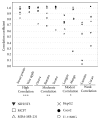Cytotoxic Effects of Chlorophyllides in Ethanol Crude Extracts from Plant Leaves
- PMID: 31379971
- PMCID: PMC6662445
- DOI: 10.1155/2019/9494328
Cytotoxic Effects of Chlorophyllides in Ethanol Crude Extracts from Plant Leaves
Abstract
Chlorophyllide (chlide) is a natural catabolic product of chlorophyll (Chl), produced through the activity of chlorophyllase (chlase). The growth inhibitory and antioxidant effects of chlide from different plant leaf extracts have not been reported. The aim of this study is to demonstrate that chlide in crude extracts from leaves has the potential to exert cytotoxic effects on cancer cell lines. The potential inhibitory and antioxidant effects of chlide in crude extracts from 10 plant leaves on breast cancer cells (MCF7 and MDA-MB-231), hepatocellular carcinoma cells (Hep G2), colorectal adenocarcinoma cells (Caco2), and glioblastoma cells (U-118 MG) were studied using MTT (3-(4,5-dimethylthiazol-2-yl)-2,5-diphenyl tetrazolium bromide) and DPPH (1,1-diphenyl-2-picrylhydrazyl) assays. The results of the MTT assay showed that chlide in crude extracts from sweet potato were the most effective against all cancer cell lines tested. U-118 MG cells were the most sensitive, while Caco2 cells were the most resistant to the tested crude extracts. The cytotoxic effects of chlide and Chl in crude extracts from sweet potato and of commercial chlorophyllin (Cu-chlin), in descending order, were as follows: chlide > Chl > Cu-chlin. Notably, the IC50 of sweet potato in U-118 MG cells was 45.65 μg/mL while those of Chl and Cu-chlin exceeded 200 μg/mL. In the DPPH assay, low concentrations (100 μg/mL) of chlide and Cu-chlin from crude extracts of sweet potato presented very similar radical scavenging activity to vitamin B2. The concentration of chlide was negatively correlated with DPPH activity. The current study was the first to demonstrate that chlide in crude extracts from leaves have potential cytotoxicity in cancer cell lines. Synergism between chlide and other compounds from leaf crude extracts may contribute to its cytotoxicity.
Conflict of interest statement
The authors declare that there are no conflicts of interest regarding the publication of this paper.
Figures





Similar articles
-
Altering the expression of the chlorophyllase gene ATHCOR1 in transgenic Arabidopsis caused changes in the chlorophyll-to-chlorophyllide ratio.Plant Physiol. 2002 Apr;128(4):1255-63. doi: 10.1104/pp.010813. Plant Physiol. 2002. PMID: 11950974 Free PMC article.
-
Cytotoxic activity of extracts and crude saponins from Zanthoxylum armatum DC. against human breast (MCF-7, MDA-MB-468) and colorectal (Caco-2) cancer cell lines.BMC Complement Altern Med. 2017 Jul 17;17(1):368. doi: 10.1186/s12906-017-1882-1. BMC Complement Altern Med. 2017. PMID: 28716103 Free PMC article.
-
The formation of chlorophyll from chlorophyllide in leaves containing proplastids is a four-step process.FEBS Lett. 2000 Dec 15;486(3):243-6. doi: 10.1016/s0014-5793(00)02309-7. FEBS Lett. 2000. PMID: 11119711
-
Antioxidant and Cytotoxic Effect of Barringtonia racemosa and Hibiscus sabdariffa Fruit Extracts in MCF-7 Human Breast Cancer Cell Line.Pharmacognosy Res. 2016 Jan-Mar;8(1):66-70. doi: 10.4103/0974-8490.171104. Pharmacognosy Res. 2016. PMID: 26941539 Free PMC article.
-
Plant-growth regulators alter phytochemical constituents and pharmaceutical quality in Sweet potato (Ipomoea batatas L.).BMC Complement Altern Med. 2016 May 28;16:152. doi: 10.1186/s12906-016-1113-1. BMC Complement Altern Med. 2016. PMID: 27234523 Free PMC article.
Cited by
-
Harnessing the health benefits of purple and yellow-fleshed sweet potatoes: Phytochemical composition, stabilization methods, and industrial utilization- A review.Food Chem X. 2024 May 20;23:101462. doi: 10.1016/j.fochx.2024.101462. eCollection 2024 Oct 30. Food Chem X. 2024. PMID: 38974195 Free PMC article. Review.
-
Screening of Specific and Common Pathways in Breast Cancer Cell Lines MCF-7 and MDA-MB-231 Treated with Chlorophyllides Composites.Molecules. 2022 Jun 20;27(12):3950. doi: 10.3390/molecules27123950. Molecules. 2022. PMID: 35745070 Free PMC article.
-
Anti-Cancer Activity and Phenolic Content of Extracts Derived from Cypriot Carob (Ceratonia siliqua L.) Pods Using Different Solvents.Molecules. 2021 Aug 19;26(16):5017. doi: 10.3390/molecules26165017. Molecules. 2021. PMID: 34443605 Free PMC article.
-
Guava (Psidium guajava L.) Leaves: Nutritional Composition, Phytochemical Profile, and Health-Promoting Bioactivities.Foods. 2021 Apr 1;10(4):752. doi: 10.3390/foods10040752. Foods. 2021. PMID: 33916183 Free PMC article. Review.
-
In Vitro Cytotoxicity of Reproductive Stage Withania somnifera Leaf and Stem on HepG2 Cell Line.Evid Based Complement Alternat Med. 2023 Dec 26;2023:8832166. doi: 10.1155/2023/8832166. eCollection 2023. Evid Based Complement Alternat Med. 2023. PMID: 38169931 Free PMC article.
References
LinkOut - more resources
Full Text Sources
Other Literature Sources
Miscellaneous

